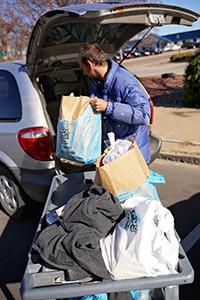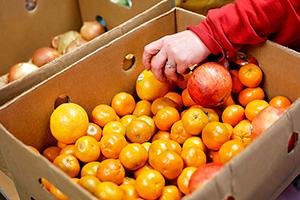Fighting hunger is all about the details
The Salvation Army is a leader in the fight against hunger. We have been for 150 years.
But what, exactly, do the frontlines of hunger look like? Where and how does The Salvation Army serve?
 In Minnesota and North Dakota, we operate dozens of food shelves and hot meal programs in cities large and small. Together, these programs served more than 800,000 hot meals and nearly 190,000 bags of groceries last year.
In Minnesota and North Dakota, we operate dozens of food shelves and hot meal programs in cities large and small. Together, these programs served more than 800,000 hot meals and nearly 190,000 bags of groceries last year.
That’s the big picture. Look closer, and you’ll discover that The Salvation Army’s effectiveness in hunger abatement is because of our attention to detail. We strive to create innovative food programs that serve unique needs and stretch donations further.
“Just as successful companies cater to the specific needs of their clients, so too does The Salvation Army cater to the specific needs of its guests,” affirmed Lt. Col. Robert Thomson, Salvation Army Commander of Minnesota and North Dakota.
Specificity
Our food shelf in Brainerd, Minn., is a stellar example of how The Salvation Army tailors food programs to fit specific needs.
 The Brainerd food shelf (pictured) serves 30 to 40 people and families per day, four days a week, with the help of four volunteers.
The Brainerd food shelf (pictured) serves 30 to 40 people and families per day, four days a week, with the help of four volunteers.
Here’s where it gets interesting: Those experiencing homelessness receive a special set of food items.
“For people living outside, we provide foods that are easy to prepare and can be cooked over a campfire, like hamburgers and hot dogs,” said Linda Loftus, Brainerd food shelf coordinator. “We also offer special snap-top boxes of food for people living in their cars. These boxes are filled with foods that are easy to heat or can be eaten cold, along with plates, cups and silverware they can take with them.”
The food shelf even caters to kids.
“We have our fun programs, like Halloween bags with little candies and a big box of Raisinets,” Loftus said. “The kids just love it. We want them to feel comfortable when they come in.”
 To further meet specific needs, many Salvation Army food shelves offer culturally-specific foods, including Asian, Hispanic and African fare. The Salvation Army in Maplewood, Minn., recently adopted this program.
To further meet specific needs, many Salvation Army food shelves offer culturally-specific foods, including Asian, Hispanic and African fare. The Salvation Army in Maplewood, Minn., recently adopted this program.
“We have been active in finding additional food resources to accommodate the diets of our guests,” said Landis Dean, social worker at the Maplewood Salvation Army. “These populations are very happy with our efforts. Some appreciative Asian families twice brought us egg rolls, even though we tell them it’s not necessary, we’re just doing our jobs.”
Two more examples of tailored food programs: The Salvation Army in Duluth, Minn., offers a medical food shelf for people with doctor-referred dietary needs. And several Twin Cities Salvation Army food shelves are specifically designed for homeless youth.
Helping hurting families
Salvation Army food shelves are a godsend to people like Chris, a Brainerd resident caring for his two nephews while their mother battles mental health issues. Although he has worked most of his life, he is currently unemployed and looking for work.
 “I’m trying to help my sister and her kids, but it’s almost financially impossible,” Chris said. “This food shelf bridges the gap. It’s a blessing.”
“I’m trying to help my sister and her kids, but it’s almost financially impossible,” Chris said. “This food shelf bridges the gap. It’s a blessing.”
Our food shelves are a blessing to thousands of other families. Earlier this fall, a Salvation Army social worker offered this about one of those families:
A father was referred to our food shelf by a school social worker. His kids had told a school counselor that their father had lost his job of 30 years and had no money for food or to pay the bills. The father reluctantly contacted us for help, embarrassed because he had never needed emergency services. We gave him a large supply of food, told him about energy assistance programs, and invited him to come back. He was very touched and thankful.
Saddle up, partners
Salvation Army food shelf and hot meal programs are able to serve more people by stretching resources through valued partnerships. Specifically, we connect with local grocery stores that give us overstock items and nearly-expired fruits, veggies and bread – called “rescued food.”
These partnerships allow our 16 hot meal programs in Minnesota and North Dakota to serve food at a lower cost, which frees financial resources for other Salvation Army programs like rent assistance.
 The Salvation Army in Virginia, Minn., for example, cooks a free hot dinner every weeknight, with many of the ingredients donated by local grocers. Longtime kitchen volunteers Marcene Drift (pictured, left) and Claudy Lehman (right) often use the donations to whip up their specialty: Italian fare.
The Salvation Army in Virginia, Minn., for example, cooks a free hot dinner every weeknight, with many of the ingredients donated by local grocers. Longtime kitchen volunteers Marcene Drift (pictured, left) and Claudy Lehman (right) often use the donations to whip up their specialty: Italian fare.
“We for sure serve it once a month,” said Drift, while rolling homemade meatballs. “Our other specialties are ribs, and soup – chicken noodle and tomato basil.”
As for our food shelves, rescued food allows families to receive food more frequently than normal, as most Salvation Army locations are only equipped to allow guests one grocery visit per month. But thanks to rescued food, our food shelves almost always offer free bread on a daily basis, plus fresh fruits, vegetables, meats, and other perishables, as resources allow.
 The Salvation Army in Hibbing, Minn., for example, gets two big shipments of fresh produce every month. In Brainerd, they get some almost every day, including lettuce, avocados, squash, apples and more.
The Salvation Army in Hibbing, Minn., for example, gets two big shipments of fresh produce every month. In Brainerd, they get some almost every day, including lettuce, avocados, squash, apples and more.
“We get our (rescued) foods from the local Cub Foods, Walmart, Costo and Target,” Loftus said. “If we have a lot available, we tell people to take whatever they can use. Otherwise, we tell people to take two or three items so that everybody can have some.”
The Salvation Army is excited to offer fresh foods whenever possible.
“We have a big push for healthy foods because it’s cheaper to buy chips and soda here up north,” said Lt. Grant Holloway (pictured at top of story), co-leader of the Brainerd Salvation Army. “We’re known in the community for our healthy foods. We even give recipes for healthy eating in our food boxes.”
Please join The Salvation Army in the fight against hunger by donating or volunteering in your local community.
